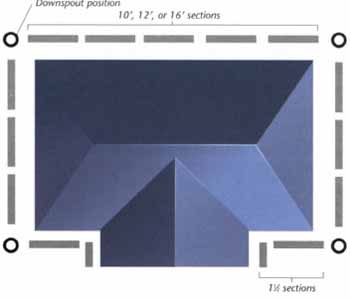Preparing to Install Gutters
| HOME | Prev: Types of Gutters | Next: Installing Vinyl Gutters |
|
|
Installation is a simple, methodical process, but the technique will vary slightly depending on the gutter type. Plan thoroughly the layout and components needed. In most cases it will simply be a case of replacing like with like, so it may be worth making a sketch of how the components of the old system are arranged. Familiarize yourself with how to assemble the joints used with your system and know how to position a ladder and information on scaffolding. Arrange to have somebody to help you do the work.. OTHER THINGS TO CONSIDER• If fascia boards need to be painted, paint them before attaching new gutters. • Trim back any long sections of roofing felt so that they lip into the gutter, but ensure that they do not block the water flow. • Use a tool-belt to hold tools safely while you are working on a ladder. • After installation, test gutters by pouring in a bottle of water at the highest point to make sure everything is working properly. REMOVING OLD GUTTERSWhether or not it's difficult to remove old gutters depends on what material it's made of, and how easy it's to gain access to it. Aim to carry the gutters down the ladder with you, rather than allowing them to drop to the ground. If the gutters are very high, or it's difficult to set up a ladder, get a professional to take down the old gutters and replace them. If you are removing metal gutters, bear in mind that they may be heavy. Make sure the area below where you are working is clear. Another alternative to ladders or fixed scaffolding is to rent either pipe staging or a power lift. MEASURING FOR NEW GUTTERSGutters need to slope towards a running outlet to ensure that water drains away efficiently. The gradient needed is very slight — only 1:500, which amounts to 1 in (25mm) in every 50 ft (15 m). In practice, you do not need to work it out precisely, but just make sure that the gutters slope all the way down to the running outlet (as shown below) — and that it slopes even while turning any corners. On a particularly long run of gutter, the fascia board may not be deep enough to accommodate the gradient required. In this case, a running outlet may be positioned centrally along the length of a fascia board, with lengths of gutter on either side running downhill toward it. The number and position of downspouts will therefore be very much dependent on the length of a gutter run, and also where the downspout can direct water to drainage. In most cases, these routes will be well established, but on new projects some more detailed planning will be required. ESTIMATING QUANTITIESBasic estimate: If possible, measure lengths of the old gutter and the downspouts. Otherwise, measure around the building at ground level, and measure its height. Feed a rigid tape measure up a wall to find the height for the downspout. Waste and trim: Buy about 10 percent extra. Gutters tend to come in standard lengths, which you will have to cut to size, so some will be wasted. Clips: The number of clips needed per length may be specified by the manufacturer. Otherwise, aim for one every 2 yd (2 m) on metal gutters and every 1 yd (1 m) on vinyl gutters. Union and brackets: If you are using vinyl gutters, work out how many joints there will be between lengths: you will need a union bracket for each joint. TOOLS / MATERIALS:Installing vinyl gutters: Ladder or scaffolding*, string line, file, level or gradient level Installing metal gutters: Ladder or scaffolding*, string line, file, level or gradient level hacksaw, sealant dispenser*, sealant*, nuts*, bolts* * = optional |
|
| HOME | Prev: Types of Gutters | Next: Installing Vinyl Gutters |
